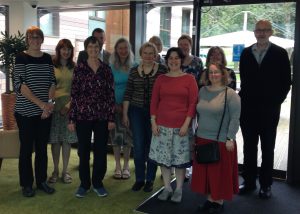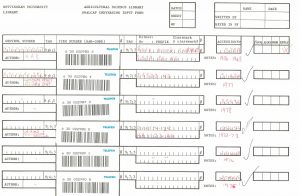July 21, 2016, by Sarah
Light at the end of the tunnel for retroconversion

Members of the retroconversion project team. Retroconversion means the conversion of the existing records in manually produced catalogues into machine-readable form
Colleagues old and new came together recently to celebrate the conclusion of the retrospective cataloguing project. The project tackled the problem of catalogue records which were ‘of their time’ and converting them into machine-readable form.
Started in 1984, the project took longer to complete than the construction of the Dartford Tunnel – over 30 years! Even so, it was still completed ahead of schedule: we initially thought it might take until 2025!
Chris Middleton, Associate Director Content and Discovery thanked all those present who had been involved with the project over the years. Chris reflected on how things have changed in terms of how students find the material they need.
The thing that has changed least is the subject of the catalogue record – the book. Before 1984, staff and students at the university used the card catalogues. Any of you who remember card catalogues will know how laborious and inefficient it is to search through cards by author, title or subject. The book would then have been manually issued and stamped with the due date.
In 1984, the library started to automate its catalogue. There still wasn’t an online catalogue for readers, who were now using microfiche, but automated circulation was possible using the SWALCAP system which went live in 1985.

The Swalcap conversion input form – a cunning scheme allowing a barcode to be allocated alongside basic book details which were then keyed in later. However, this led to many imperfect catalogue records and hence the lengthy process of retrospective enhancement and completion
Dick Chamberlain, Section Head of Collection & Access Management until he retired in 2012, writes:
“The prospect of completing total conversion was completely unreal in those days. But just being able to make available multiple copies (on microfiche) of a partial union catalogue was a huge breakthrough. Before then the Hallward card catalogue was the only place where you could see records of stock in all libraries – now you could provide a copy anywhere.”

Chris Middleton, Associate Director Content and Discovery, thanking colleagues for their hard work, determination and accuracy
However, the ongoing process seemed never ending. In 1991 the library acquired Libertas, our first online catalogue, and real-time updating of catalogue records and downloading from external databases became possible. The 1990s were a time of many collective efforts across HE sector. The Follett Report and Research Support Libraries Programme led to a number of projects which improved cataloguing standards, and Nottingham’s own Janet Wharton, played a major part in establishing these national standards. In 2000, the library acquired the Aleph library management system, and with it an online web catalogue. Reclassification of specific problem areas led to completion of retro-conversion in those areas, bringing us to where we are today, at the long tail of completion.
“Completing retroconversion seems to require the engagement of every opportunity – even though some are not without considerable pain!”
Janet Wharton, Senior Librarian Collections & Metadata
Wharton, Janet (2011) Slow, slow, quick, quick, slow: retrospective conversion at the University of Nottingham. Catalogue and Index, 164 . pp. 8-11. ISSN 0008-7629
No comments yet, fill out a comment to be the first


Leave a Reply